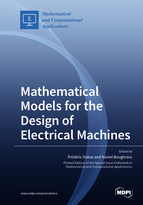Mathematical Models for the Design of Electrical Machines
A special issue of Mathematical and Computational Applications (ISSN 2297-8747). This special issue belongs to the section "Engineering".
Deadline for manuscript submissions: closed (31 October 2020) | Viewed by 47767
Special Issue Editors
Interests: applied mathematics; partial differential equations; separation of variables method; principle of superposition; (semi-)analytical modeling; subdomain technique; magnetic equivalent circuit; electrical machines
Special Issues, Collections and Topics in MDPI journals
Interests: electromagnetic field; electrical machines; analytical methods; numerical methods
Special Issue Information
Dear Colleagues,
Electrical machines are used in many electrical engineering applications, viz., transports (e.g., electric/hybrid/fuel cell vehicles, railway traction, aerospace, etc.), energy harvesting (e.g., flywheel, etc.), renewable energy (e.g., wind power turbine, hydroelectric power plant, etc.), magnetic refrigeration device, etc. For decades, numerical methods (i.e., the finite-element, finite-difference or boundary-element analysis) have been widely used in R&D departments for their accuracy as compared to measurements. Nevertheless, mainly in 3-D, these approaches are time-consuming and not suitable for the optimization problems. Nowadays, in order to reduce the computation time, R&D engineers must develop full computer-aided-design for electrical machines with accurate and fast models in simulations. Hence, the main objective of this Special Issue is to bring the latest advances and developments in mathematical modeling and design of electrical machines for different applications. The main models discussed will be based on the:
- Equivalent circuits (e.g., electrical, thermal, magnetic, etc.);
- Schwarz-Christoffel mapping method;
- Maxwell-Fourier (i.e., multi-layers models, eigenvalues models, subdomain technique).
The interest topics in the mathematical models include, but are not restricted to:
- 2-D, quasi 3-D and 3-D;
- Global/local saturation, slotting and/or eddy-current effects;
- Adaptive Generic models;
- Multi-physic modeling with new materials;
- Hybrid models.
The numerical method as well as the experimental tests will be used as comparisons or validations.
Assoc. Prof. Dr. Frédéric Dubas
Prof. Dr. Kamel Boughrara
Guest Editors
Manuscript Submission Information
Manuscripts should be submitted online at www.mdpi.com by registering and logging in to this website. Once you are registered, click here to go to the submission form. Manuscripts can be submitted until the deadline. All submissions that pass pre-check are peer-reviewed. Accepted papers will be published continuously in the journal (as soon as accepted) and will be listed together on the special issue website. Research articles, review articles as well as short communications are invited. For planned papers, a title and short abstract (about 100 words) can be sent to the Editorial Office for announcement on this website.
Submitted manuscripts should not have been published previously, nor be under consideration for publication elsewhere (except conference proceedings papers). All manuscripts are thoroughly refereed through a single-blind peer-review process. A guide for authors and other relevant information for submission of manuscripts is available on the Instructions for Authors page. Mathematical and Computational Applications is an international peer-reviewed open access semimonthly journal published by MDPI.
Please visit the Instructions for Authors page before submitting a manuscript. The Article Processing Charge (APC) for publication in this open access journal is 1400 CHF (Swiss Francs). Submitted papers should be well formatted and use good English. Authors may use MDPI's English editing service prior to publication or during author revisions.







